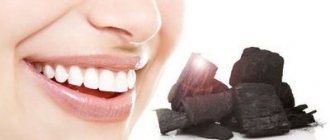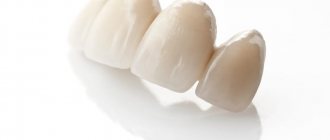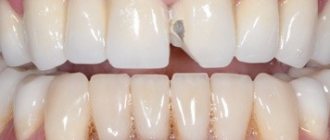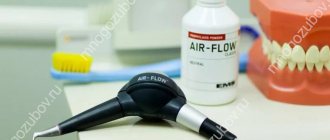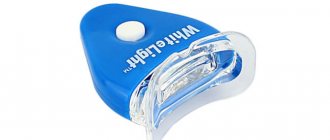Is it possible to whiten metal-ceramic crowns?
Unfortunately, it is impossible to achieve perfect whitening of fillings and metal-ceramic crowns. So, for example, modern dental ceramics is a fairly dense and hard material, so the brightening compounds used today have practically no effect on it.
The photo shows a metal-ceramic crown
But if the restored areas and prosthetic structures are located in the posterior parts of the jaw, the front teeth can be whitened. Then the difference in shades will not be noticeable. Otherwise, it will not be possible to achieve uniform whitening and an aesthetically pleasing smile. To do this, you will have to look for other solutions to the problem.
Is it possible to lighten an artificial tooth that has been made too dark?
No, you won't be able to do this. After all, the shade of the ceramic is selected at the stage of making the prosthesis - then the product is baked in an oven, and the color is fixed forever. If the dentist made a mistake with the shade, then he will either have to redo the prosthesis (change the ceramic lining on a metal-ceramic crown, for example), or even make a new orthopedic structure.
There is another option - to apply a special white varnish on top of the ceramic prosthesis (for example, Dental Paint). It will paint the crown or veneer only on top, and after several cleanings it will wash off. Therefore, such a solution to the problem cannot be called a high-quality solution.
How to paint metal ceramics
One of the options for lightening fillings and crowns is to stain them. For this purpose, various compositions are used today: liquid enamel, professional dental paints and varnishes. Recently, Dental Paint has gained particular popularity. One of its main advantages is that it allows you to paint even hard-to-reach places, and also successfully solves the problem of darkening of filling materials, crowns and dentures. With its help, you can achieve lightening of up to 10 tones, and at the same time the result will look natural1.
Dental Paint can be used to lighten teeth
However, this method also has one significant drawback - the effect will be short-lived, so the procedure will soon have to be repeated. This method is similar to applying makeup, because the paint will be washed off after the first brushing of your teeth. Yes, and you cannot use such products on an ongoing basis, since this can lead to the destruction of the filling or crown. The materials from which they are made do not absorb paint, so it is impossible to change their color in this way. In such cases, dental experts recommend timely replacement of restorative materials and prostheses.
How to protect yourself from problems with dentures
In order for new teeth to maintain an attractive appearance for a long time and not cause other problems, you must initially carefully approach the choice of a clinic and an orthopedic dentist. It is advisable if dentistry has its own dental laboratory, where modern and high-quality ceramic materials are used. For example, ceramics, glass ceramics, fluorapatite, zirconium dioxide from Ivoclar Vivadent (IPS E.Max), Prettau, Kuraray Noritake, VITA Zahnfabrik. And the specialists were trained by material manufacturers, i.e. know how to handle them correctly.
Another important step is that before prosthetics, professional cleaning with ultrasound and Air-Flo is required, and sometimes professional whitening. After all, if your enamel is covered with plaque, then it looks darker than its natural shade - that is, the prosthesis will be made the same color. And then the patient wants to whiten his teeth or even just have his teeth professionally cleaned - as a result, the crown or veneer will turn out to be darker than the rest of the row. Therefore, do not neglect professional cleaning BEFORE prosthetics - a good dentist himself will offer to undergo it, because... understands all the risks.
Ultrasonic cleaning and its effectiveness
You can restore the natural whiteness of your smile and lighten artificial crowns a little using the procedure of Prof. hygiene. The method involves cleaning teeth from plaque and deposits, and today various technologies are used for this purpose, including an ultrasonic scaler. This is a hardware technique that involves delivering ultrasonic waves and microvibrations through a special tip, which literally break hardened deposits into tiny particles. At the same time, a jet of water is supplied, which removes dirt and also protects the enamel surface from overheating.
As part of comprehensive hygiene, ultrasonic or laser cleaning is usually combined with sandblasting of enamel using an Air-Flow device. This is a mandatory preventive procedure that should be performed every six months. But here it is worth noting that it will not help whiten either fillings or crowns. Lightening occurs only by removing plaque and deposits.
The photo shows the method of brushing teeth with the Air Flow system.
Can dentures be whitened?
Can ceramic teeth be whitened? Imagine ordinary dishes made of ceramics and glass - these compositions are inert to chemical bleaches, peroxide, vinegar and other acids, and alkalis. After all, even in laboratories, aggressive chemicals are stored in such containers - and the shade of their walls does not change.
Thus, ceramic veneers, crowns, restoration inlays, and bridges cannot be whitened using chemical methods. Or just lighten the surface darkening a little - and then while it is “fresh”. Those. until the dyes and plaque have eaten into the microscopic pores and cracks on the surface of the ceramic. Abrasive pastes will also only remove surface deposits, and can only harm the prosthesis itself - if solid particles scratch the top coating, it will lose its aesthetics even faster.
Why is it better to do whitening after filling, but before prosthetics?
If you want to undergo a whitening procedure, but also have a filling, you still need to take care of your dental health first. For example, professional in-office whitening is carried out only after removing plaque and deposits, installing fillings or replacing them. You should immediately discuss your plans with your doctor and select the material of the desired shade.
As for prosthetics with crowns, this procedure can be carried out after bleaching. This will make it easier to choose a ceramic shade that exactly matches the current enamel color.
When is it better to stop whitening?
The procedure for whitening tooth enamel is not always safe for the health of teeth and the entire body. There are a number of restrictions under which it is better to postpone the procedure or abandon it altogether.
Relative contraindications:
- inflammatory, infectious or viral diseases of the oral cavity;
- respiratory diseases;
- pregnancy and lactation period;
- treatment of bite with braces;
- taking potent medications.
Depending on the method of whitening, absolute contraindications may differ, but any procedure is not performed on children under 16 years of age, intoxicated, with mental disorders and the risk of allergies to the drug used.
Veneers as one of the options for solving the problem
Returning to the question of how to whiten metal-ceramic teeth, it must be repeated that the paints and varnishes existing on the market today cannot ensure long-lasting results, so patients have to look for other alternative solutions to the problem. For example, you can install veneers - thin snow-white overlays that are fixed on the front surface of the teeth using a special adhesive composition, thereby masking any minor defects, including chips, pigmentation, slight curvature and crevices.
Veneers can help change the color of teeth
Modern veneers are created from durable ceramics or glass ceramics, which are quite resistant to mechanical stress and are not subject to staining. However, before installing them, the teeth have to be ground down, and they will not return to their original state.
“I had a large filling on my front tooth since my youth, when I was involved in professional sports. Naturally, over time it became gray, and this was very noticeable. At some point I simply stopped smiling and complexes appeared. That's why I decided to get veneers. The doctor recommended E.max, it is glass ceramic, it looks beautiful and natural. It’s already been three years since I installed it, nothing has chipped anywhere, as they scared me. So I'm very pleased."
Nika11.91, from correspondence on the forum www.32top.ru
Therefore, an even better option is Lumineers. These are very thin and at the same time durable plates, the installation of which does not require preliminary preparation of the enamel. In both cases, it is first necessary to take impressions of the patient’s teeth, and microprostheses will be created based on them. There is also the option of installing veneers using the direct method - in this case, the doctor will cover the teeth with a layer of composite. However, there are some nuances here. For example, the material can also fade over time and is typically inferior in strength and durability to veneers created from impressions in a laboratory.
Reasons for discoloration of prosthetic structures
Immediately after installation, dentures look attractive, but over time their aesthetics often decrease. The reason for this may be poor quality materials. If acrylic or nylon with an insufficiently dense structure are used for manufacturing, then dyes easily penetrate into the existing micropores. And then, with each use of colored products, the aesthetic characteristics of the prosthesis decrease: its surfaces darken and lose their shine.
But even high-quality structures can gradually change their color. Reasons for this:
- Incorrect use of the prosthesis. In particular, you should not immediately eat cold foods after hot foods.
- Insufficient care. The structure cannot be cleaned with abrasive powders. You should also not neglect hygiene procedures. Poor cleaning contributes to the formation of a bacterial film on artificial teeth and gums.
- Violation of the composition of microflora in the oral cavity. It is bad if the balance shifts in favor of pathogenic microorganisms. In this case, the prosthesis can quickly become covered with a dark coating produced by certain types of bacteria.
Is it possible to whiten teeth at home?
To maintain the natural whiteness of your teeth, it is important to brush them twice a day with a properly selected brush and toothpaste, rinse your mouth after every meal, use floss and antibacterial rinses, give up cigarettes and coffee, and undergo a professional procedure. hygiene every six months.
But if you naturally have a slightly yellowish or grayish tint to your enamel, even following all of the above measures will not be able to ensure an impeccably white smile. To do this you will have to resort to bleaching. This can be done at home in several ways:
- pencil - brightening gel is produced in a special tube, at the end of which there is usually a soft brush, brush or sponge for convenient application of the composition to the enamel surface. You must use the whitening pencil strictly according to the instructions. Typically, the gel is applied twice in the morning and evening for 2 weeks.
- strips and aligners - the gel can be immediately applied to the strips, which should be glued to the outside of the teeth for a certain time. Other systems include special mouth guards. Their inner surface must be independently coated with a lightening composition and then put on the dentition,
- abrasive pastes - they usually contain coarse abrasive particles, due to which the whitening effect is achieved. However, you cannot use them on an ongoing basis, otherwise you can damage the enamel, which will lead to its weakening and increased sensitivity - the development of hyperesthesia.
When whitening at home, a tray with a special gel is often used.
Before trying any of the methods described above, you should definitely consult a doctor. The specialist will conduct a visual inspection and determine the current condition of the enamel, and give his recommendations on choosing the appropriate system. If the enamel is weakened, thinned or too sensitive, the use of whitening strips and abrasive pastes is strictly contraindicated.
Is teeth whitening harmful?
Very often our patients ask whether teeth whitening is harmful. It's actually safe. We use modern systems where the active gel composition is not dangerous for a limited exposure time.
When you go to a real clinic and see an experienced doctor, you don’t need to be afraid of anything. We do not recommend smile whitening in salons where the procedure is performed by personnel without dental training.
Different professional teeth whitening systems require the use of gel of different concentrations. During the consultation, the doctor will determine the condition of your enamel and choose the optimal concentration that will not cause severe sensitivity after the procedure.
Principles of caring for metal-ceramic crowns
To prevent darkening of fillings and crowns, it is important to provide competent and systematic oral care. As mentioned above, basic hygiene rules include regular brushing of teeth twice in the morning and evening, rinsing after each meal, as well as visiting the dentist for prevention and cleaning of dental plaque at least once every six months.
If you have a bridge in your mouth with metal-ceramic crowns, it is important not to forget to clean the rinsing channel located between the gum and the structure. An irrigator is ideal for these purposes. Experts in the field of prosthetics also provide the following recommendations regarding the care of metal ceramics:
- try to avoid temperature changes in food and drinks, due to which the porosity of the material increases and it turns yellow,
- If possible, avoid coffee and strong black tea, since these drinks quickly lead to staining,
- You should not gnaw hard foods with your teeth or crack the shells of nuts and seeds.
An irrigator is an additional device for maintaining oral hygiene.
To keep your teeth healthy and your smile snow-white, you need to pay enough attention to caring for and maintaining hygiene. Modern fillings are made from high-quality materials that cannot be stained for a long time. The same can be said about modern dental ceramics, which are distinguished by their durability, high aesthetics and color fastness. Therefore, with proper care, the material will not darken and will retain its aesthetic properties throughout its entire service life.
1According to data at the office. manufacturer's website: dentalpaint.ru.
When to see a doctor
It is necessary to visit a doctor for preventive purposes every six months. This rule applies not only to those who have crowns, but also to all other patients. If there are restorations with crowns in the row. You should have your teeth professionally cleaned by a hygienist every year. This will keep the structures clean, extend their service life and avoid the appearance of an unpleasant odor. During a preventive examination, a specialist will be able to identify disorders that have not yet made themselves known to the patient. An unscheduled visit is necessary in the following cases:
- The crown became movable.
- An unpleasant odor appeared. There is redness of the gums.
- It is painful to bite into a restored tooth.
- Discomfort or any unpleasant sensations appeared.
A timely visit will allow you to promptly identify and eliminate the cause of discomfort, avoiding complications.
Author:
Mayorov Andrey Mikhailovich
Specialization:
orthopedic dentistry, dental prosthetics, implant installation
